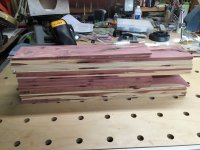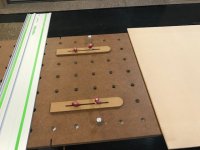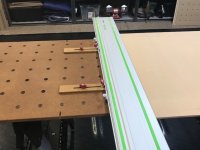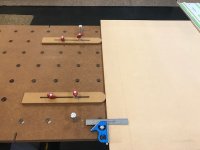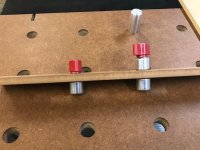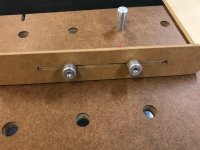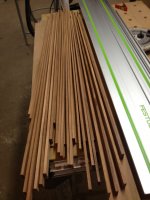You are using an out of date browser. It may not display this or other websites correctly.
You should upgrade or use an alternative browser.
You should upgrade or use an alternative browser.
Repetitive Thin Rips
- Thread starter Curt
- Start date
tjbnwi
Member
- Joined
- May 12, 2008
- Messages
- 7,149
Cheese
Member
[attachimg=1]
A table saw...here’s 30 pieces of aromatic cedar ripped to width within a 15 minute time span.
The track saw system is great but it has its limitations. If that’s the only tool you own it works...if you own other tools there are alternative and sometimes faster methods.
Even though I use the table saw less after I purchased the Festool track saw system, I’d never sell the table saw because the table saw is more efficient in many sawing instances. Match the tool to the chore.
Curt said:What is your method for dealing with repeating thin rips - as in cutting face frame pieces from a stick of hardwood?
A table saw...here’s 30 pieces of aromatic cedar ripped to width within a 15 minute time span.
The track saw system is great but it has its limitations. If that’s the only tool you own it works...if you own other tools there are alternative and sometimes faster methods.
Even though I use the table saw less after I purchased the Festool track saw system, I’d never sell the table saw because the table saw is more efficient in many sawing instances. Match the tool to the chore.
Attachments
MrToolJunkie
Member
- Joined
- Jul 6, 2009
- Messages
- 3,021
Tom's method and description is among the best on this forum that I have read. I book marked the thread not long after he posted it. I use a rule stop to get repetitive rips - not as fast as a table saw, but it works well. TSO has some interesting new products to set stops that I want to explore when they are back in stock.
AlexThePalex
Member
- Joined
- Nov 12, 2008
- Messages
- 7,808
Table saw. I'm not a one-tool-can-do-it-all guy, I prefer the best tool for the job so I can work quickly and efficiently.
Guys - I realize the table saw is the perfect tool for this particular task, but I sold mine. It's been replaced with the combination of the MFT/3 and a 17" bandsaw. I needed the space and I can fit both these tools in the space occupied by the TS with 36" rails. My intention is to move into the handtool world as far as I can. It's just that ripping hardwood by hand is not my idea of fun.
I realized that I knew of no good solutions to the issue when I started this conversion but I have learned so much. here on FOG, in the last couple of weeks that I should have known but did not, that I thought it the better part of valor to ask here. I've got a few rather cheesy designs running around in my head that probably will not work. My fallback is to cut on the bandsaw and use a jointer plane to remove the differences.
I realized that I knew of no good solutions to the issue when I started this conversion but I have learned so much. here on FOG, in the last couple of weeks that I should have known but did not, that I thought it the better part of valor to ask here. I've got a few rather cheesy designs running around in my head that probably will not work. My fallback is to cut on the bandsaw and use a jointer plane to remove the differences.
Curt said:Guys - I realize the table saw is the perfect tool for this particular task, but I sold mine. It's been replaced with the combination of the MFT/3 and a 17" bandsaw. I needed the space and I can fit both these tools in the space occupied by the TS with 36" rails. My intention is to move into the handtool world as far as I can. It's just that ripping hardwood by hand is not my idea of fun.
I realized that I knew of no good solutions to the issue when I started this conversion but I have learned so much. here on FOG, in the last couple of weeks that I should have known but did not, that I thought it the better part of valor to ask here. I've got a few rather cheesy designs running around in my head that probably will not work. My fallback is to cut on the bandsaw and use a jointer plane to remove the differences.
I hope that you will post what your ideas are. Yes, that does take guts sometimes on the internet and in a forum like this. The Festool trainers mention in their classes about how the tools are used relatively low as to what they can do. There isn't a stupid idea out there in my mind when it comes to using the Festools and the "system." The number of things I have learned here and then did a head slap is enormous.
The Trainers also learn from users of their tools and who knows, maybe you will come up with the next tip and trick they show!
Peter
Honestly, the festool parallel guides get a pretty bad rap around here, but I think they'd do this just fine. It depends on how long the material is that you're trying to rip, but if you can support the parallel guides and just slightly float the rail above your material (or somehow allow you to slide material under the rail without the non-slip strip catching it), you should be able to get in a rhythm that will approach table saw speed.
Check out this video:=481
The key would be to somehow fix the parallel guides to the support surface so they are immobilized and you can just keep sliding your material to the stop.
Check out this video:=481
The key would be to somehow fix the parallel guides to the support surface so they are immobilized and you can just keep sliding your material to the stop.
Cheese
Member
Curt said:Guys - I realize the table saw is the perfect tool for this particular task, but I sold mine. It's been replaced with the combination of the MFT/3 and a 17" bandsaw.
My fallback is to cut on the bandsaw and use a jointer plane to remove the differences.
I’ve used the bandsaw before but in conjunction with a jointer and a planer and it works well. The only issue is there are a lot of additional steps added to the process.
If you have a track saw then I’d go with Tom’s method. Rip the wood plus a little sanding and you’re good to go.
I have also had a lot of problems with repetitive cuts using the tracksaw:
1. Until Festool comes out with a Sawstop style table saw, Im stuck with the track saw, as I value my fingers too much! Table saw is the No. 1 most dangerous power tool, according to reports.
2. I tried making a jig, but it was not accurate enough, none of the links to John's pictures work anymore also
3. I have decided to purchase a jig, I think I only have 3 choices: Festool, Seneca or Woodpeckers. Any recommendations? I think the woodpeckers is too expensive for the amount of times I may use it.
1. Until Festool comes out with a Sawstop style table saw, Im stuck with the track saw, as I value my fingers too much! Table saw is the No. 1 most dangerous power tool, according to reports.
2. I tried making a jig, but it was not accurate enough, none of the links to John's pictures work anymore also
3. I have decided to purchase a jig, I think I only have 3 choices: Festool, Seneca or Woodpeckers. Any recommendations? I think the woodpeckers is too expensive for the amount of times I may use it.
Alex said:Table saw. I'm not a one-tool-can-do-it-all guy, I prefer the best tool for the job so I can work quickly and efficiently.
There is a reason why Festool offers 4 routers, 4 track saws, and -- oops -- I lost count of thr number of sanders.
MrToolJunkie
Member
- Joined
- Jul 6, 2009
- Messages
- 3,021
I get repetitive rips using a rule stop or just striking a line on all the pieces with an Incra ruler and aligning to the track. I get perfect results or within a thou between pieces. The Parallel Guides work great on sheet goods and when you can support the end of the track.
I just bought some stop collars for my long dogs and am going to try using these to set the thickness of the material and support the rail on my MFT and then rip thinner stock using above method or some other stop using MFT dogs or TSO's new stop system (when it is available for order). I think this will yield good results.
Your bandsaw will work great too - a blade without set and a well-tuned machine can yield accurate results. I have ripped thousands of feet of lumber on my bandsaw and they are all just as good of cuts as my table saw. Lots of ways to get from point a to point b and there is no one right or wrong way.
I just bought some stop collars for my long dogs and am going to try using these to set the thickness of the material and support the rail on my MFT and then rip thinner stock using above method or some other stop using MFT dogs or TSO's new stop system (when it is available for order). I think this will yield good results.
Your bandsaw will work great too - a blade without set and a well-tuned machine can yield accurate results. I have ripped thousands of feet of lumber on my bandsaw and they are all just as good of cuts as my table saw. Lots of ways to get from point a to point b and there is no one right or wrong way.
Peter Halle said:I hope that you will post what your ideas are. Yes, that does take guts sometimes on the internet and in a forum like this. The Festool trainers mention in their classes about how the tools are used relatively low as to what they can do. There isn't a stupid idea out there in my mind when it comes to using the Festools and the "system." The number of things I have learned here and then did a head slap is enormous.
The Trainers also learn from users of their tools and who knows, maybe you will come up with the next tip and trick they show!
Peter
Before I start designing with serious intent, I need to know the capabilities of everything currently out there. I also prefer to use a gauging approach as opposed to error fraught measuring. So I need some form of adjustable stops, a rail support that is variable height. Probably have to set a limit = to the MFT/3 long dimension which is sufficient for most face frame rails & stiles. The hard part might be the rail clips but maybe TSO already has the answer.
How do you rip narrow cuts from a Narrow board?
Lets say you have a 7" wide board that you want to make 2" wide rips on? The piece will be lost under the Festool track, so do these parallel guides work in that situation?
I understand how it works when the board is wider than the Festool track.
Lets say you have a 7" wide board that you want to make 2" wide rips on? The piece will be lost under the Festool track, so do these parallel guides work in that situation?
I understand how it works when the board is wider than the Festool track.
There's a number of ways to do this, but if you're cutting on an MFT table and using dogs to line up your rail, you just need to use a couple scraps from the same thickness material, cut a 1/4" slot and use some short rail dogs and knobs to have a sliding stop. When all set up, I draw a line and check with a square to make sure it's dialed in before cutting. Very fast and accurate. I've cut the slot on a router before I got my Shaper Origin ... now I have a cut file I can use for different materials. For those of you with a Shaper .. you can fine the file on the Shaper Hub.
Attachments
Pretty genius! Sort of what I was thinking about but my thoughts trended to 2 pairs of tracks each pair connected at the sides but sliding to act as the stops - outer tracks anchored by dogs which also act as rail stops. Consider your idea stolen. Thank you very much!TrackTubesGuy said:There's a number of ways to do this, but if you're cutting on an MFT table and using dogs to line up your rail, you just need to use a couple scraps from the same thickness material, cut a 1/4" slot and use some short rail dogs and knobs to have a sliding stop. When all set up, I draw a line and check with a square to make sure it's dialed in before cutting. Very fast and accurate. I've cut the slot on a router before I got my Shaper Origin ... now I have a cut file I can use for different materials. For those of you with a Shaper .. you can fine the file on the Shaper Hub.
Similar threads
- Replies
- 11
- Views
- 499
- Replies
- 3
- Views
- 593
- Replies
- 6
- Views
- 334
- Replies
- 13
- Views
- 316

